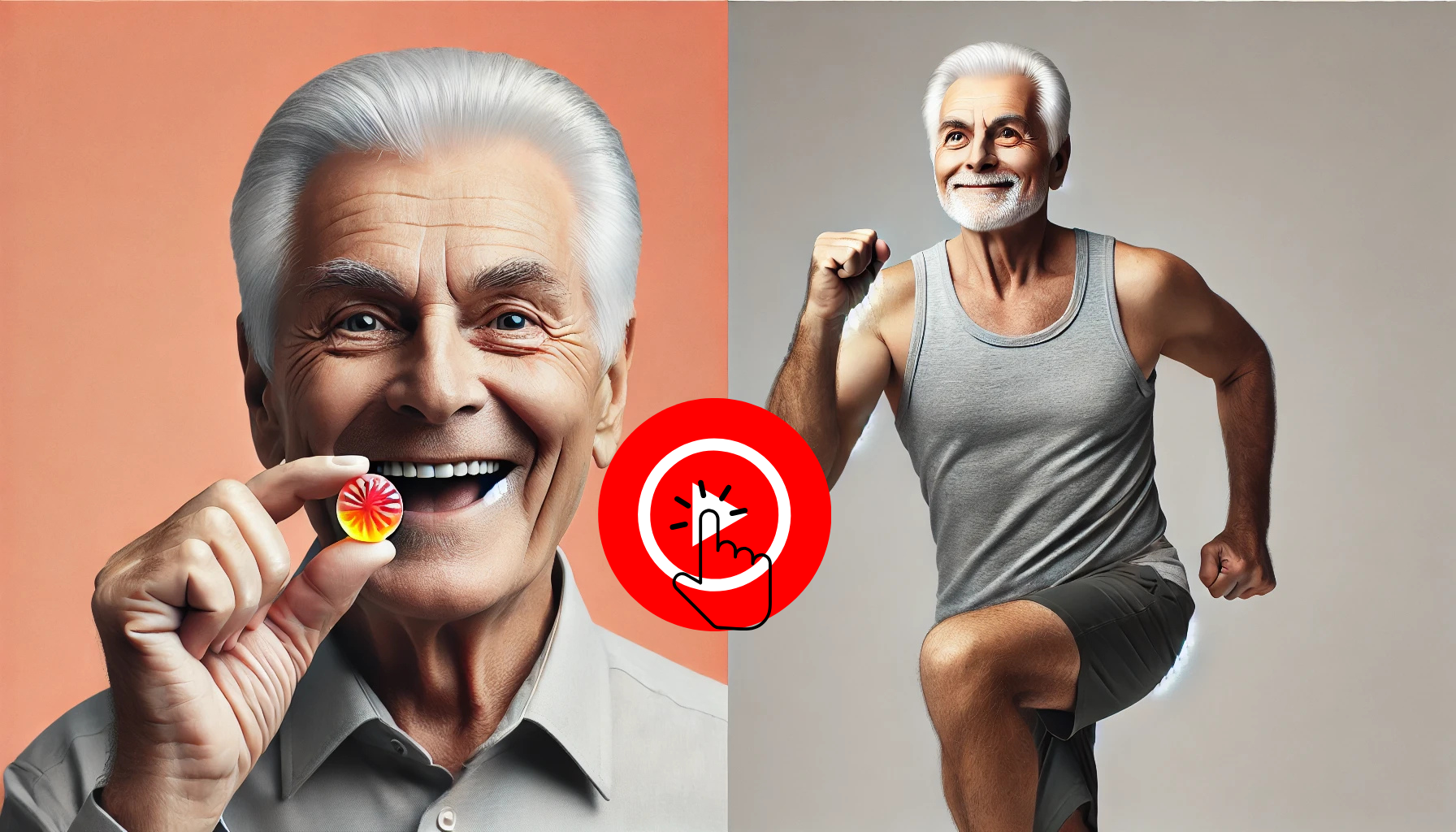natural solutions for knee pain relief: reclaiming your mobility
Discover effective, natural remedies for knee pain relief that help restore comfort and mobility after 55.
If you are overwhelmed by the burden of chronic joint pain and long to reclaim the joy of movement, now is the time to take action. Imagine waking up each day with renewed energy and the ability to enjoy activities you love, without discomfort holding you back. Thousands of seniors have transformed their lives and stepped back into a world of mobility and freedom. Don’t miss out on the opportunity to discover a natural, safe, and effective solution that has already brought relief and hope to many. Click the button below to watch a life-changing video that could be the key to your own path to pain-free living. Remember, your journey to a happier, healthier life begins today!
As we journey through life, the years can bring a myriad of changes—some beautiful, others more challenging. For many, one of those challenges is knee pain. It can feel as if we’ve lost our freedom to move, play, and enjoy life fully. Understanding that you are not alone in this struggle is the first step toward finding relief. This article guides you through the common causes of knee discomfort and presents natural alternatives that have helped countless individuals reclaim their lives.
why joint pain increases with age

As people age, joint pain often becomes more common. This is due to several factors, including:
Wear and Tear on Joints
Over the years, our joints can experience wear and tear. Everyday activities, such as walking or running, can lead to joint damage. Even simple tasks can cause strain on the knees, leading to discomfort over time.
Cartilage Damage
Joint cartilage helps cushion the bones and supports smooth movement. With age, this cartilage can wear down, leading to increased pain and stiffness. Less cushioning results in bones rubbing together, which can cause inflammation and discomfort.
Arthritis Risk
Older adults are more prone to conditions like arthritis. This disease causes inflammation in the joints, leading to chronic pain and stiffness. Osteoarthritis, the most common form, is especially associated with aging.
Reduced Muscle Strength
As people grow older, they may lose muscle mass and strength. Weaker muscles mean less support for the joints, leading to increased vulnerability to injuries and discomfort.
Inflammation in Joints
With aging, the body can experience higher levels of inflammation. This can contribute to pain and swelling in the knees and other joints. Finding ways to manage this inflammation is crucial.
traditional anti-inflammatory drugs and their shortcomings

Traditional anti-inflammatory drugs are commonly prescribed to help manage pain and reduce inflammation. However, they come with several shortcomings that can affect their long-term use.
Common Types of Anti-Inflammatory Drugs
Nonsteroidal anti-inflammatory drugs (NSAIDs) like ibuprofen and naproxen are popular choices. They can be effective for short-term relief of pain and swelling. Yet, reliance on them for extended periods can lead to several issues.
Side Effects
One major drawback of these medications is their potential side effects. Prolonged use of NSAIDs can lead to problems like stomach ulcers, kidney damage, and increased risk of heart attack. This can make patients hesitant to take them regularly.
Temporary Relief
While anti-inflammatory drugs can provide quick relief, they do not address the root cause of joint pain. This means that even if pain levels drop, the underlying issues, such as cartilage damage or arthritis, may persist.
Dependency Risk
The use of anti-inflammatory medications can create a cycle of dependency for some individuals. This can lead to increased dosages over time, which amplifies the risk of side effects and other health complications.
Natural Alternatives
As concerns grow over the long-term use of anti-inflammatory drugs, more people explore natural alternatives. Methods such as physical therapy, dietary changes, and supplements like boswellia extract show promise in managing pain without the risks associated with traditional medications.
the emotional impact of chronic pain

Chronic pain can have a deep emotional impact on individuals. Living with pain day in and day out can lead to feelings of frustration, sadness, and isolation.
Understanding Emotional Responses
Many people experience a range of emotions when facing chronic pain. It is common to feel frustration when the pain interrupts daily life or limits activities. This frustration can turn into feelings of hopelessness, making it hard to see a way forward.
Effects on Mental Health
Chronic pain is closely linked to mental health issues such as anxiety and depression. Constant discomfort can wear down one’s mental resilience, leading to higher stress levels. For some, it’s a struggle to maintain a positive outlook.
Impact on Relationships
Living with chronic pain can strain relationships. Friends and family may not fully understand the experience, which can lead to feelings of isolation. Patients might withdraw from social interactions, feeling like a burden or fearing judgment from others.
Coping Mechanisms
Finding effective coping strategies is essential. Many individuals benefit from talking to a therapist or joining a support group. These resources can provide a space to share experiences and learn from others facing similar challenges.
The Role of Communication
Open communication with loved ones can improve relationships. Expressing feelings about the emotional toll of chronic pain can help others understand what one is going through. This understanding can foster compassion and support.
understanding chronic inflammation

Chronic inflammation is a prolonged immune response that can harm the body over time. Unlike acute inflammation, which is a normal response to injury or infection, chronic inflammation can last for months or even years.
Causes of Chronic Inflammation
Several factors contribute to chronic inflammation. These may include:
- Long-term exposure to irritants, such as pollution.
- Autoimmune diseases, where the body mistakenly attacks healthy cells.
- Persistent infections that the body cannot clear.
- Lifestyle factors, such as poor diet, lack of exercise, and chronic stress.
Symptoms of Chronic Inflammation
Symptoms can vary widely but may include:
- Fatigue
- Joint pain and stiffness
- Digestive issues
- Skin problems, such as rashes
- Frequent colds or infections
Consequences of Chronic Inflammation
Chronic inflammation can lead to serious health issues over time. It is associated with conditions such as:
- Heart disease
- Diabetes
- Arthritis
- Certain cancers
Managing Chronic Inflammation
To manage chronic inflammation, it is essential to address both diet and lifestyle. Incorporating more anti-inflammatory foods—like fruits, vegetables, and healthy fats—can help reduce inflammation. Regular physical activity and stress management techniques are also crucial for overall health.
natural remedies for arthritis in the knees
Many people seek natural remedies for arthritis in the knees to alleviate pain and improve mobility without relying on medications. Several options can help manage symptoms effectively.
Turmeric
Turmeric contains a compound called curcumin, which has powerful anti-inflammatory properties. Taking turmeric supplements or adding it to meals may help reduce swelling and pain in the knees.
Ginger
Ginger is another natural anti-inflammatory that can support joint health. It can be consumed in teas, smoothies, or meals to help ease knee pain.
Omega-3 Fatty Acids
Foods rich in omega-3 fatty acids, such as fish and flaxseeds, can reduce inflammation in the body. Incorporating these into your diet may help manage arthritis symptoms.
Physical Activity
Low-impact exercises, like swimming or cycling, can strengthen the muscles around the knees and improve flexibility. Regular activity can reduce stiffness and pain.
Hot and Cold Therapy
Applying heat can relax muscles and improve circulation, while cold packs can reduce inflammation and numb sharp pain. Alternating between heat and cold may provide relief.
Hyaluronic Acid
Some people find relief using hyaluronic acid supplements, which can help lubricate the joints and reduce pain in people with osteoarthritis.
Healthy Weight
Maintaining a healthy weight can reduce stress on the knees, making it easier to move without pain. Eating a balanced diet combined with regular exercise can help achieve this goal.
real testimonials of pain relief

Hearing from others can provide hope and inspiration when dealing with pain. Real testimonials of pain relief offer personal stories and experiences that highlight various methods for finding relief.
Story of John
John, a 60-year-old retiree, struggled with knee pain for years. He found that incorporating daily stretches and gentle exercises helped reduce his discomfort. “I never thought I could walk without pain again, but these simple changes made a big difference in my life,” John shares.
Mary’s Experience
Mary, a 55-year-old nurse, turned to natural remedies when traditional medications failed. She started taking turmeric supplements and noticed a significant decrease in inflammation. “I feel like I have my life back, and I can enjoy activities with my grandkids again!” she says.
Alex’s Journey
At 45, Alex faced chronic back pain that impacted his work and daily life. After trying physical therapy, he began to notice improvements. “I was skeptical at first, but with the right therapist, I learned how to manage my pain effectively. Taking control of my health was empowering,” Alex explains.
Susan’s Success
Susan, at 50, struggled with arthritis. She found relief by switching to an anti-inflammatory diet rich in fruits and vegetables. “I never expected that food could have such an impact on my pain levels. It’s been life-changing,” she shares.
Collective Impact
These testimonials show how varied experiences can lead to successful outcomes. Each story emphasizes the importance of exploring different pain relief methods and finding what works best for you. Listening to others provides both comfort and motivation to continue the search for relief.
the role of boswellia extract and hemp for pain relief

Boswellia extract and hemp are gaining attention as natural options for pain relief. Both have unique properties that can help manage discomfort effectively.
Boswellia Extract
Boswellia, derived from the resin of the Boswellia tree, contains anti-inflammatory properties. It helps block the production of inflammatory mediators, easing pain associated with conditions like arthritis. Many users report reduced pain and improved mobility after taking Boswellia supplements.
How to Use Boswellia
Boswellia is available in various forms, including capsules, powders, and topical creams. Consuming it regularly may bring noticeable relief. It’s essential to consult a healthcare professional to determine the right dosage.
Hemp and CBD
Hemp is noted for its cannabidiol (CBD) content, a compound known for its pain-relieving properties. CBD interacts with the body’s endocannabinoid system, which plays a role in regulating pain and inflammation. Many find that using CBD oil or topical applications helps reduce discomfort.
Benefits of Using Hemp
Hemp products, including oils and edibles, often have minimal side effects compared to traditional pain medications. They can provide a holistic approach to managing pain, making them a favorite among those seeking natural remedies.
Combining Boswellia and Hemp
Some people find that combining Boswellia extract and hemp-based products enhances their overall pain relief. This combination may target inflammation on multiple fronts, offering a more comprehensive approach to managing discomfort.
Always Consult a Doctor
Before starting any new supplement, especially for pain relief, it’s vital to speak with a healthcare professional. They can help you find the best combination for your needs and ensure it does not interact with other medications.
steps to avoid knee surgery
Avoiding knee surgery is a common goal for many people suffering from knee pain. By making specific lifestyle changes and following targeted strategies, you may manage your knee pain effectively and preserve your mobility.
Weight Management
Maintaining a healthy weight is essential. Excess weight puts extra stress on the knees, which can worsen pain and inflammation. Aim for a balanced diet combined with regular exercise to achieve and maintain a healthy weight.
Physical Therapy
Engaging in physical therapy can be very beneficial. A physical therapist can design an individualized program that focuses on strengthening the muscles around your knees, improving flexibility, and enhancing overall stability.
Low-Impact Exercises
Incorporating low-impact exercises into your routine can help alleviate pressure on the knees. Activities such as swimming, cycling, and walking are gentle on the joints while promoting strength and endurance.
Stretching and Strengthening
Regular stretching and strengthening exercises are vital in supporting knee health. Focus on strengthening your quadriceps and hamstrings to provide better support for your knees. Simple stretches can help maintain flexibility and reduce stiffness.
Proper Footwear
Wearing appropriate footwear can significantly affect knee pain. Shoes that provide proper arch support and cushioning help reduce impact and alignment issues. Avoid high heels or worn-out shoes that may worsen discomfort.
Heat and Cold Therapy
Using heat and cold therapy can be effective for managing knee pain. Heat can relax tight muscles, while cold packs can reduce swelling and numb sharp pain. Alternate between the two as needed for the best results.
Nutrition and Supplements
A nutritious diet rich in anti-inflammatory foods can help reduce symptoms. Some people find relief through supplements like glucosamine and chondroitin, which may support joint health. Always consult a healthcare professional before starting any new supplements.
If you are overwhelmed by the burden of chronic joint pain and long to reclaim the joy of movement, now is the time to take action. Imagine waking up each day with renewed energy and the ability to enjoy activities you love, without discomfort holding you back. Thousands of seniors have transformed their lives and stepped back into a world of mobility and freedom. Don’t miss out on the opportunity to discover a natural, safe, and effective solution that has already brought relief and hope to many. Click the button below to watch a life-changing video that could be the key to your own path to pain-free living. Remember, your journey to a happier, healthier life begins today!





Seja o primeiro a comentar!